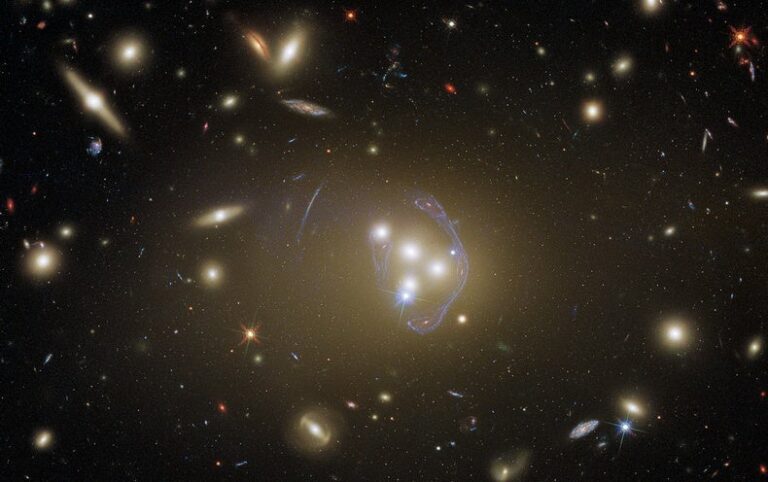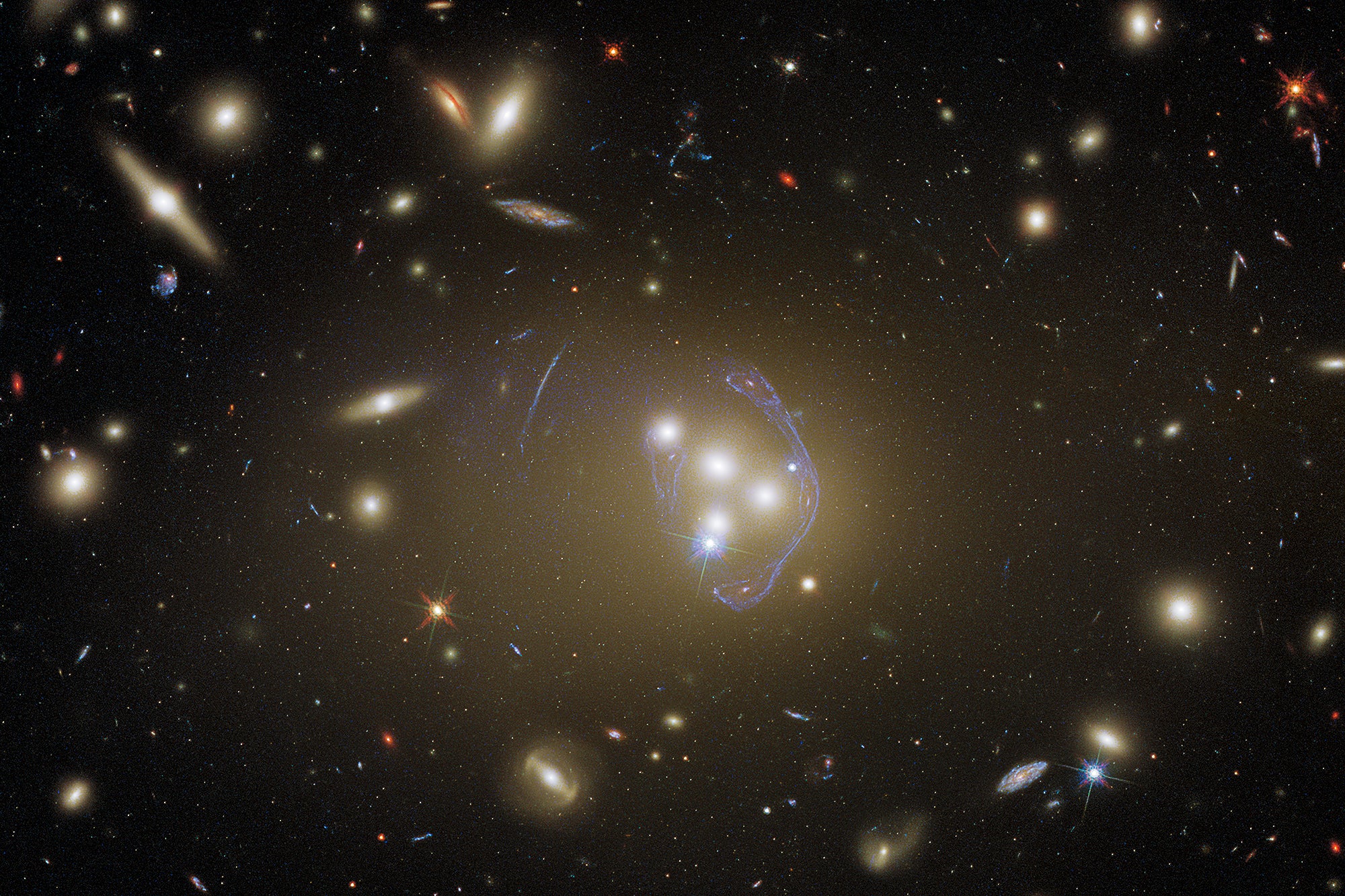
[ad_1]

If you’re looking for intergalactic eye candy and cosmic bling, it’s hard to beat Abell 3827, a crowded cluster of hundreds of galaxies about 1.3 billion light-years from Earth. Hubble Space Telescope images of the cluster show a bright central quartet of merging galaxies shimmering like diamonds and perched on an ethereal azure engagement ring. But Abell 3827 boasts more than superficial beauty—it offers deeper allure for curious astrophysicists.
For all its gleam, only some 10 percent of the cluster’s mass is visible. The remaining 90 percent exists in halos of an invisible substance called dark matter—halos so massive that the cluster bends nearby spacetime to act as a giant magnifying glass, which astronomers call a gravitational lens. The wispy, glowing “engagement ring” wrapped around the cluster’s center is actually a set of amplified, warped and multiplied apparitions of a fortuitously aligned, far-distant background galaxy. And theorists have been puzzling over the mirror images’ strange dark-matter-sculpted specifics for years.
“I’ve never seen something like this before,” says Jenny Wagner, a theoretical astrophysicist at the Bahamas Advanced Study Institute and Conferences. “When I looked at the cluster, I thought, ‘Something is not right here,’” she recalls. “I couldn’t point my finger at what was not right.”
Because of its unique circumstances and appearance, Abell 3827 is one of the best places astronomers can look for clues about what exactly dark matter actually is. The mysterious substance constitutes 80 percent of the universe’s mass and is central to modern cosmological models, yet it has eluded direct detection for nearly 90 years. Precisely mapping the gravitationally lensed arcs of light and mirror images that surround Abell 3827 allows scientists to weigh the cluster and determine where and how much dark matter it holds.
But how many contorted images does Abell 3827 display? It depends on who you ask. For more than a decade, many teams of physicists have squinted to identify and trace each of its accompanying distorted images by eye. They have variously reported four, six or even eight mirages of the background galaxy circling the cluster, with each number suggesting a slightly different distribution for Abell 3827’s dark matter. Many of the apparent mirror images are also unusually rotated with respect to one another. Additionally, previous research has flagged the motions of its four central merging galaxies as a potential probe for the presence of self-interacting dark matter (SIDM), a hypothetical variety of dark matter that could form more complex structures than the standard type, which is thought to be more cosmically inert. But there, too, researchers have reached conflicting conclusions, with some reporting evidence consistent with SIDM and others finding no such thing. Despite Abell 3827’s vast potential, for astronomers seeking to clarify its hidden workings, the galaxy cluster remains a muddled mess. “It’s a big car crash that’s happening,” says Richard Massey of England’s Durham University, who was not involved in the new research but has studied Abell 3827 in detail. “As the police say, everyone who witnesses a car crash tells a completely different version of events.”
Gravitational Lenses: From Pancakes to Waffles
Now Wagner and two of her colleagues have proposed a new theory that might settle some of these discrepancies. Instead of some elusive quirk of dark matter causing Abell 3827’s uniquely hazy and askew gravitationally lensed images of a background galaxy, the researchers argue that the real culprit is the galaxy cluster’s unexpectedly complex lensing morphology. The trio proposes that rather than being “flat as a pancake,” as standard lensing models assume, Abell 3827 is acting as a thicker, more three-dimensional lens with correspondingly stronger aberrations on its projected fuzzy wreath of images. “Imagine you have a Belgian waffle, and you put it very far from you; it will look like a pancake,” Wagner says. “But the closer it gets, the more you will see that it actually has a thick structure along the line of sight.”
Dark matter researchers studying gravitationally lensing galaxy clusters have long preferred pancake-flat models for the sake of simplicity because a lensing cluster’s thickness is negligible, compared with the billion-light-year distances that separate most of them from Earth. That approach, however, can only explain the shearing or stretching of images, not the puzzling orientations that are seen in Abell 3827, Wagner says.
The new theory, which the team recently published in the Monthly Notices of the Royal Astronomical Society, relies on the premise that the galaxies in the central quartet do not lie at a single distance and are instead spread along our line of sight. So the background galaxy’s light must be lensed not instantaneously, as conventionally modeled, Wagner says, but multiple times along a distance of 46 million light-years, which is the estimated thickness of the Abell 3827 galaxy cluster. According to the team’s “waffle” hypothesis, one lensing galaxy in the central quartet that is significantly closer to Earth than the rest could be partly responsible. Previous research has shown that three of the galaxies are akin to pearls on a string, roughly equidistant from us in the plane of the sky. the fourth appears to be closer to us by about 32 million light-years, however. So the background galaxy’s light is very likely lensed not once but at least twice before it hits our telescopes, Wagner says.
The cluster is a “chaos of galaxies running around in an unprecedented fashion,” Wagner says, so future observations that precisely measure speeds of galaxies relative to each other would help validate this hypothesis. If her new theory stands up, it would also strengthen the case that putative signs of SIDM that were previously glimpsed in the cluster can be better explained as spurious products of flawed dark matter models. And physicists may also have to revise those models to incorporate multiple gravitational lenses within other light-warping galaxy clusters. “The role of other structures along the line of sight has been an important question for lensing analysis,” says Adi Zitrin, an expert in galaxy cluster analysis at Ben-Gurion University of the Negev in Israel, who was not involved in the new study. “In practice, however, it is something that we often neglect, either because we want to make things simpler or because we don’t have the data.”
Guesswork and “Ghost Clumps”
To better map the distribution of mirror images around Abell 3827, Wagner and her team developed an image analysis tool to automatically identify and correlate distinguishing features between the warped arcs of light. When the tool failed to identify a few features reported in earlier works, the team traced this discrepancy to previous human errors in mapping the lensed images—errors that had then compounded after being incorporated into subsequent models. “We should bear in mind: we have models. They have their limitations,” Wagner says, “and the question for me always is: How crazy can physics be, and when am I just wrong in my modeling?”
Other scientists agree current dark matter models—many of which simulate a gravitational lens as a flat, two-dimensional object—are prone to human errors and inevitably rely on guesswork. A common problem with the models, Wagner and her team noticed, was the presence of “ghost clumps”—anomalous globs of mass that the models predicted to exist around the cluster where observations suggested there is only empty space. As per the “waffle” hypothesis, adding a second gravitational lens to the models that better simulate the thickness of the galaxy cluster should resolve the problem of ghost clumps, Wagner says, although “one would need to set up a new way of lens modeling” to really confirm it.
Not everyone is convinced just yet, however, that the new theory can satisfactorily explain Abell 3827’s confusing assortment of distorted images. Liliya Williams of the University of Minnesota, who has studied the galaxy cluster, suspects the math behind Wagner and her colleagues’ image analysis tool breaks down for the cluster’s lensed images, which are about four times larger in angular size than those of most other known gravitational lenses. “I wonder if the conclusion of the thick lens comes from pushing their method beyond the limit where it is applicable,” says Williams, who was not involved in the study.
“I don’t know that it is the most compelling, but I think that it is at least as plausible as other interpretations that have been out there,” says Tim Hamilton of Shawnee State University, who was not part of the study. “With the amount of information we have at this point, it is probably the simplest way of modeling it without trying to introduce extra complications.”
Contrary to Wagner and her team’s conclusions, other experts say one of those interpretations remains the tantalizing possibility of SIDM, which may be interacting with itself below our current detection limits. More images of the cluster and its baffling lensed images will help astronomers better map the distribution of mass within Abell 3827, which can then reveal whether the cluster’s stars are offset from its dark matter—a potential smoking-gun signature of SIDM.
Massey, who spearheaded much of the work tying Abell 3827 to SIDM models, remains convinced that dark matter must self-interact in at least a minuscule way to exist in the first place. Spotting such subtle and elusive behavior written in the warped light of distant galaxies, he says, is something “we might be able to achieve within the next decade.”
[ad_2]